
A lunar eclipse is an astronomical event that occurs when the Moon moves into the Earth's shadow, causing the Moon to be darkened. Such an alignment occurs during an eclipse season, approximately every six months, during the full moon phase, when the Moon's orbital plane is closest to the plane of the Earth's orbit.
An eclipse is an astronomical event.
This is a list of fictional stories in which solar eclipses feature as an important plot element. Mere passing mentions are not listed.

A solar eclipse occurs when the Moon passes between Earth and the Sun, thereby obscuring the view of the Sun from a small part of the Earth, totally or partially. Such an alignment occurs approximately every six months, during the eclipse season in its new moon phase, when the Moon's orbital plane is closest to the plane of the Earth's orbit. In a total eclipse, the disk of the Sun is fully obscured by the Moon. In partial and annular eclipses, only part of the Sun is obscured. Unlike a lunar eclipse, which may be viewed from anywhere on the night side of Earth, a solar eclipse can only be viewed from a relatively small area of the world. As such, although total solar eclipses occur somewhere on Earth every 18 months on average, they recur at any given place only once every 360 to 410 years.
Midnight sun is a natural phenomenon that occurs when the Sun remains visible at the local midnight.
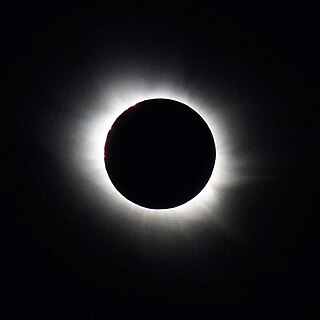
A total solar eclipse occurred on March 20, 2015. A solar eclipse occurs when the Moon passes between Earth and the Sun, thereby totally or partly obscuring the image of the Sun for a viewer on Earth. A total solar eclipse occurs when the Moon's apparent diameter is larger than the Sun's, blocking all direct sunlight, turning day into darkness. Totality occurs in a narrow path across Earth's surface, with a partial solar eclipse visible over a surrounding region thousands of kilometres wide. This total solar eclipse is notable in that the path of totality passed over the North Pole. Totality was visible in the Faroe Islands and Svalbard.

A total solar eclipse occurred at the Moon's descending node of the orbit in North America on February 26, 1979.

A partial solar eclipse took place on February 15, 2018. A solar eclipse occurs when the Moon passes between Earth and the Sun, thereby totally or partly obscuring the image of the Sun for a viewer on Earth. A partial solar eclipse occurs in the polar regions of the Earth when the center of the Moon's shadow misses the Earth.
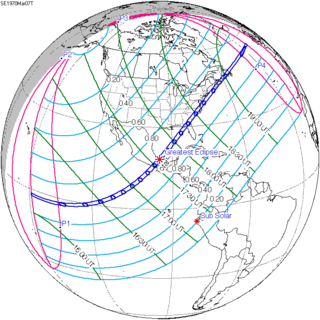
A total solar eclipse occurred on March 7, 1970, visible across most of North America and Central America.

A total solar eclipse occurred on October 24, 1995. A solar eclipse occurs when the Moon passes between Earth and the Sun, thereby totally or partly obscuring the image of the Sun for a viewer on Earth. A total solar eclipse occurs when the Moon's apparent diameter is larger than the Sun's, blocking all direct sunlight, turning day into darkness. Totality occurs in a narrow path across Earth's surface, with the partial solar eclipse visible over a surrounding region thousands of kilometres wide. The path of totality went through Iran, Afghanistan, Pakistan, India, southwestern tip of Bangladesh, Burma, Thailand, Cambodia, Vietnam, Spratly Islands, northeastern tip of Sabah of Malaysia, Philippines and Indonesia.
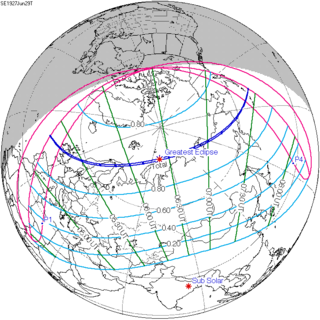
A total solar eclipse occurred on June 29, 1927. A solar eclipse occurs when the Moon passes between Earth and the Sun, thereby totally or partly obscuring the image of the Sun for a viewer on Earth. A total solar eclipse occurs when the Moon's apparent diameter is larger than the Sun's, blocking all direct sunlight, turning day into darkness. Totality occurs in a narrow path across Earth's surface, with the partial solar eclipse visible over a surrounding region thousands of kilometres wide. The path of totality crossed far northern Europe and Asia, including the United Kingdom, Norway, Sweden, Finland and Soviet Union on June 29 (Wednesday), and finally passed Amukta in Alaska on June 28 (Tuesday).
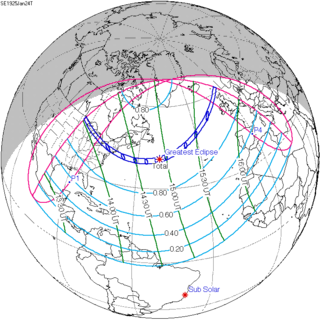
A total solar eclipse occurred on January 24, 1925. A solar eclipse occurs when the Moon passes between Earth and the Sun, thereby totally or partly obscuring the image of the Sun for a viewer on Earth. A total solar eclipse occurs when the Moon's apparent diameter is larger than the Sun's, blocking all direct sunlight, turning day into darkness. Totality occurs in a narrow path across Earth's surface, with the partial solar eclipse visible over a surrounding region thousands of kilometres wide. Totality was visible from southwestern and southeastern Quebec in Canada, and the United States, including Toronto, Niagara Falls and the northern part of New York City.

A total solar eclipse occurred on September 22, 1968. A solar eclipse occurs when the Moon passes between Earth and the Sun, thereby totally or partly obscuring the image of the Sun for a viewer on Earth. A total solar eclipse occurs when the Moon's apparent diameter is larger than the Sun's, blocking all direct sunlight, turning day into darkness. Totality occurs in a narrow path across Earth's surface, with the partial solar eclipse visible over a surrounding region thousands of kilometres wide. Totality was visible from the Soviet Union and Xinjiang in Northwestern China.

A total solar eclipse occurred on July 20, 1963. A solar eclipse occurs when the Moon passes between Earth and the Sun, thereby totally or partly obscuring the image of the Sun for a viewer on Earth. A total solar eclipse occurs when the Moon's apparent diameter is at least the same size as the Sun's or larger, blocking all direct sunlight, turning day into darkness. Totality occurs in a narrow path across Earth's surface, with a partial solar eclipse visible over the surrounding region thousands of kilometres wide. Totality was visible from Hokkaido in Japan and Kuril Islands in Soviet Union on July 21, and Alaska, and Maine in the United States and also Canada on July 20. Astronomer Charles H. Smiley observed the eclipse from a U.S. Air Force F-104D Starfighter supersonic aircraft that was "racing the moon's shadow" at 1,300 mph (2,100 km/h) extending the duration of totality to 4 minutes 3 seconds. The moon was 375,819 km from the Earth.

A total solar eclipse occurred on May 28, 1900. A solar eclipse occurs when the Moon passes between Earth and the Sun, thereby totally or partly obscuring the image of the Sun for a viewer on Earth. A total solar eclipse occurs when the Moon's apparent diameter is larger than the Sun's, blocking all direct sunlight, turning day into darkness. Totality occurs in a narrow path across Earth's surface, with the partial solar eclipse visible over a surrounding region thousands of kilometres wide.
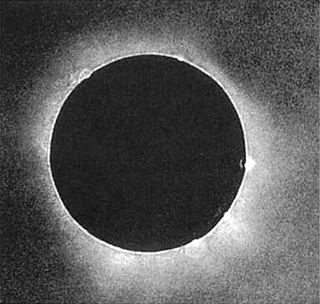
The earliest scientifically useful photograph of a total solar eclipse was made by Julius Berkowski at the Royal Observatory in Königsberg, Prussia, on July 28, 1851. This was the first occasion that an accurate photographic image of a solar eclipse was recorded.

A total solar eclipse occurred on January 1, 1889. A solar eclipse occurs when the Moon passes between Earth and the Sun, thereby totally or partly obscuring the image of the Sun for a viewer on Earth. A total solar eclipse occurs when the Moon's apparent diameter is larger than the Sun's, blocking all direct sunlight, turning day into darkness. Totality occurs in a narrow path across Earth's surface, with the partial solar eclipse visible over a surrounding region thousands of kilometres wide. It was visible across western United States, and central Canada. Partiality was visible across the northern Pacific ocean including Hawaii, and all of the United States.

A total solar eclipse occurred on July 29, 1878, over much of North America including the region of the Rocky Mountains. A solar eclipse occurs when the Moon passes between Earth and the Sun, thereby totally or partly obscuring the image of the Sun for a viewer on Earth. A total solar eclipse occurs when the Moon's apparent diameter is larger than the Sun's, blocking all direct sunlight, turning day into darkness. Totality occurs in a narrow path across Earth's surface, with the partial solar eclipse visible over a surrounding region thousands of kilometres wide. This eclipse was visible at sunrise at a path across northeastern Asia and passed across Alaska, western Canada, and the United States from Montana through Texas. It then tracked across most of Cuba and southwestern Hispaniola before ending.














